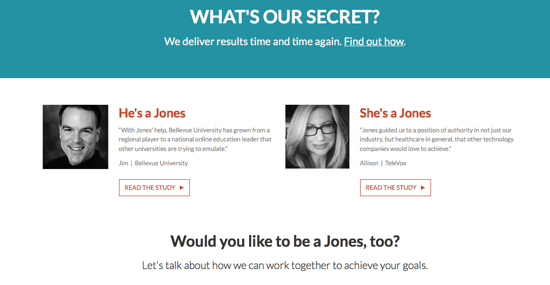Four Ways to Use Customer Proof on Your Website

No matter how great YOU say your products and services are, potential buyers are going to have doubts. They want to hear positive stories from someone else.
Real stories of how you’ve made other customers happy can be a powerful source of content for moving prospects closer to the final buying stages of the sales funnel. Testimonials, case studies and online reviews are all great ways of using customer proof to provide real life success stories that your leads need to hear.
Testimonials as Customer Proof
If you have satisfied customers, ask them to tell you why they are so happy. Short, power testimonials, featuring actual names and photos, can be used in many places throughout your website to provide extra punch and backing.
You can include one or more general testimonials on your home page, but consider placing others specifically on pages that are relevant to the experience of your satisfied customer.
If you have a testimonial speaking directly about a specific product or service, use it on the web page describing that product. More general testimonials could be used on your home page, customer service page or “About Us” page.

Using a name, title and photo with the testimonial adds authenticity. Anonymous quotations seem phony, if they aren’t. When your satisfied customer is known and respected in their industry, their word and praise is a valuable asset for your marketing content.
Read the JONES case studies that go with the testimonials shown: Bellevue University.
Case Studies as Customer Proof
Testimonials are typically short — just a few sentences — and provide a positive punch to your website content. But some prospects will be looking for more detail about how your product or service could potentially help them overcome their challenges and meet their needs.
Case studies provide a more in-depth look at your solutions at work in real life situations and the results your customers experienced. A case study should state the problem, outline the solutions, and give definitive evidence of positive results.
Don’t limit your concept of case studies to a whitepaper format, though. The in-depth information and explanation could also be presented in video format with an interview with the satisfied customer, as an image-intense infographic or a SlideShare presentation available on your website or ready to be used by your sales team in their in-person presentations. Case studies also make great blog posts:
-
Q& A: How Integrated Content Marketing Strategy Earned Primaris Leads and Awards
-
Real Life Stories of Leveraging Earned Media for Marketing Success
JONES partner HubSpot outlines 15 different ways to use case studies in this blog post.
External Online Review Sites as Customer Proof
Not all customer proof needs to be solicited and written by your marketing staff. Sometimes, it’s a matter of curating and responding to the testimonials freely provided by your customers. From Amazon, TripAdvisor and Yelp to industry-specific sites such CarTalk.com and UCompareHealthcare.com, online reviews are everywhere.
In a BrightLocal.com survey, 88 percent of respondents said they trusted online reviews as much as personal recommendations. (Click to Tweet) That means those reviews can play a significant role in customer decision-making. So when this unsolicited feedback is positive, why not put it to use?
A few tips for making the most of these reviews:
-
Claim your listing on review sites: Regularly search for your business on relevant review sites and be sure that you have updated the information given in their listings, including a link to your own website. By knowing what review sites are talking about you, you can also monitor for poor reviews and be ready to respond.
-
Incorporate reviews, either as an aggregated score or individual reviews, from recognized sites into your own web pages, such as TravelAdviser or Yelp.
-
Monitor independent review sites just as you would reviews on your own website, and respond to negative reviews as though they were direct complaints. This shows customers and potential customers you are listening to their concerns.
Wondering where to find the external sites you should be watching? Check out this list of nearly 400.
Onsite Reviews as Customer Proof
You can also enable your own website for customer reviews, capturing that customer proof directly. This may be more applicable for businesses involved in ecommerce than in B2B enterprises that rely on personal contact to close sales, but it could be worth considering.
Jayson Demers explains how to microformat onsite reviews so that they can be indexed by search engines and improve your website’s SEO in this post for Forbes.
Customer proof is just one of the 25 Website Must-Haves for Driving Traffic, Leads and Sales in our free ebook. Download it today to find more tricks that can improve your website’s marketing performance.
-1.png?width=1652&height=294&name=Jones(RGB)-1.png)












